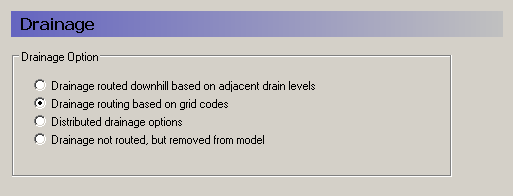
Saturated zone drainage is a special boundary condition in MIKE SHE used to defined natural and artificial drainage systems that cannot be defined in the River Network. It can also be used to simulate simple, lumped conceptual surface water drainage of groundwater.
Saturated zone drainage is removed from the layer of the SZ layer containing the drain level. Water that is removed from the saturated zone by drains is routed to local surface water bodies, local topographic depressions, or out of the model. The amount of drainage is calculated based on the groundwater head and the drain level using a linear reservoir formulation.
When water is removed from a drain, it is immediately moved to the recipient. In other words, the drain module assumes that the time step is longer than the time required for the drainage water to move to the recipient. Conceptually, you can use a “full pipe” analogy. The drain is a pipe full of water. As groundwater is added to the pipe, an equivalent amount of water must be discharged immediately out of the opposite end of the pipe because the water is incompressible and there is no additional storage in the pipe.
Each cell requires a drain level and a time constant (which is the same as a leakage factor). Both drain levels and time constants can be spatially defined. A typical drainage level might be 1m below the ground surface and a typical time constant may be between 1e-6 and 1 e-7 1/s.
Drainage reference system
MIKE SHE requires a reference system for linking the drainage to a recipient node or cell. There are four different options for setting up the drainage source-recipient reference system

· Drain Levels The drainage recipient is calculated based on the drain levels in all the down gradient cells. That is, the location of the recipient cell is calculated as if the drain water was flowing downhill (based on the drain levels). This is the most common method of specifying drainage routing and the default setting.
· Drain Codes The drainage recipient is specified by the user based on a distribution map of integer code values.
· Distributed option With this option there are several different drainage possibilities, including a combination of Codes and Levels. The Distributed option can also be used to define a specific MIKE Hydro River H-point or MOUSE manhole as a recipient.
· Removed The fourth option is simply a head dependent boundary that removes the drainage water from the model. This method does not involve routing and is exactly the same as the MODFLOW Drain boundary.